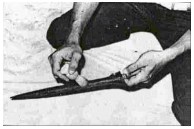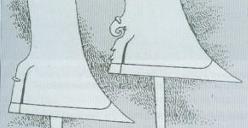|
|
|
M |
|
Mbugisan, Pamor is a pamor that is barely visible. So we call a change in color between iron and a pamor that does not appear clear. |
|
Mbuntut Tuma is one of 4 types of a blade tip of a keris or Tombak. It has the form of a tail of a louse. This form comes from Surakarta, where it is often used for blade tips of a keris. In other areas, you do not love this form. |

|
Megantara is the Dapur of a keris with 7 Luk. The luks are not up to the blade tip. It resembles the Dapur Murma Malela Jarak where Luk go to the top. The Dapur has a Kembang Kacang Pogok, only one Lambe Gajah. It has Jalen, Ri Pandan or Greneng. This Dapur has on the left side a Kruwingan and on the right side up to half the length of the blade an Ada-Ada. In this Dapur the Ganja is a ganja Wilut. Megantara is also a Dapur of a Tombak with 7 Luk. |

|
Mendak or Uwer serves the completion and garnishing of Keris. The shape is like a ring. It is set on the Pesi toward the blade side. In Sumatra, parts of Borneo, Malaysia and Brunei it is also called Cincin Keris. It is made of silver, gold, copper or brass. It is often fitted with precious stones. |



|
Parts of the Mendak |
|
Different models of a mendak are here |
|
Mendarang or Mundarang is the Dapur of a straight keris. The blade length is normal. This Dapur has a Kembang Kacang, only one Lambe Gajah, a double Sogokan, Sraweyan and full Greneng. Keris with this Dapur are quite rare . |

|
Mendung is an known Empu from Blambangan at the era of Majapahit. |
|
Mesem is a Dapur of a straight keris. The blade length is normal. The keris has Kembang Kacang, only one Lambe Gajah and otherwise no Ricikan. |
|
Metuk is a part of a Tombak and looks like a thick and large ring. This Metuk can be seen below the Sor-Soran. There is also the spelling Methuk. |




|
There are different kinds: |



|
Above from left to right: Metuk Limaran, Metuk Padma, Metuk Kupingan, Metuk Lugas and Metuk Sekar Setama
Here you find more Metuk. Metuk Limaran Robyong |
|
Minum Darah is a pamor. In Bugis it is called Nerjang Lennep. It is one of the bad pamor motives and means "drink blood". |

|
Minyak Keris is oil for a keris and is blended from various oil and other liquids. It serves the care for the keris. The best-known fragrances are Cendana (sandalwood), Melati (Jasmine), Kenanga (ylang ylang), Rase (musk), Gandapura (musk) and Pandan (Pandanus). |
|
Modin is another name for Empu Bekeljati from Tuban at the era of Majapahit. |
|
Mogleng is a form to wear a keris in Yogyakarta. The Keris is worn in the belt, rear right, and is similar to the wearing method Klabang Pinipit but the gandar is only just in the belt. This wearing method is used by people who need to be vigilant and fear danger. In Surakarta this wearing method is called Kureban. |

|
Mranggi is a person who builds a Warangak or a sarong for a keris. |






|
Mubyar is a pamor with contrast and clear images. |


|
Mucuk Bung is the form of a blade of a keris which is very thick from the haft up almost to the top without a waist. Normally one does not find an Ada-Ada. Javanese do not like this form and you will therefore find it mostly outside Java. It can be found at straight krisses and even krisses with Luk, there it is in the form Kemba.
|
|
Mulyakusuma, Kanjeng Kyai is a Pusaka keris from the Keraton of Yogyakarta. It has the Dapur Pandawa Cinarita 5 Luk, the warangka is made of sandalwood. The pendok is a pendok blewahan from tinsel.
|
|
Munggul, Pamor is a pamor and the shape looks as a boil or an ulcer. The size is about the size of the core of a mung bean, perhaps slightly larger. It belongs to the positive pamor motives. You can find it on Javanese krisses, Badík and krisses from Bugis and Luwu.
|








